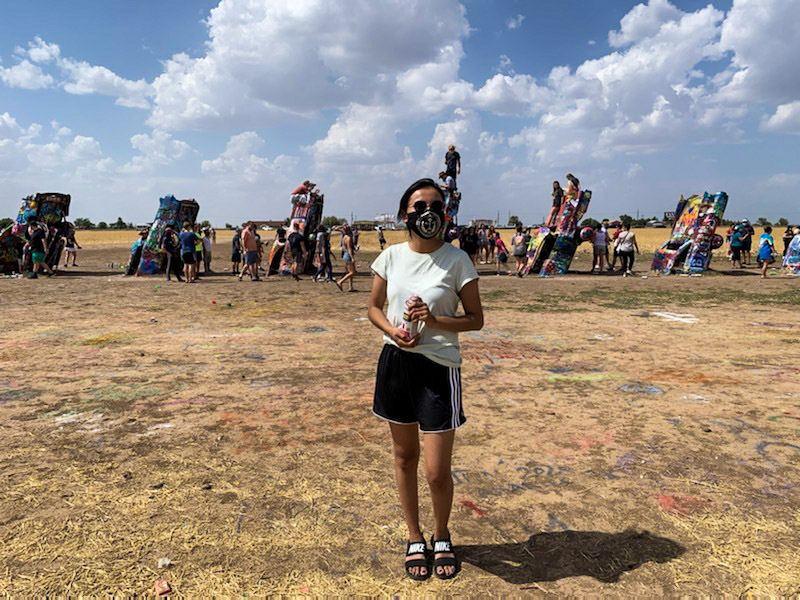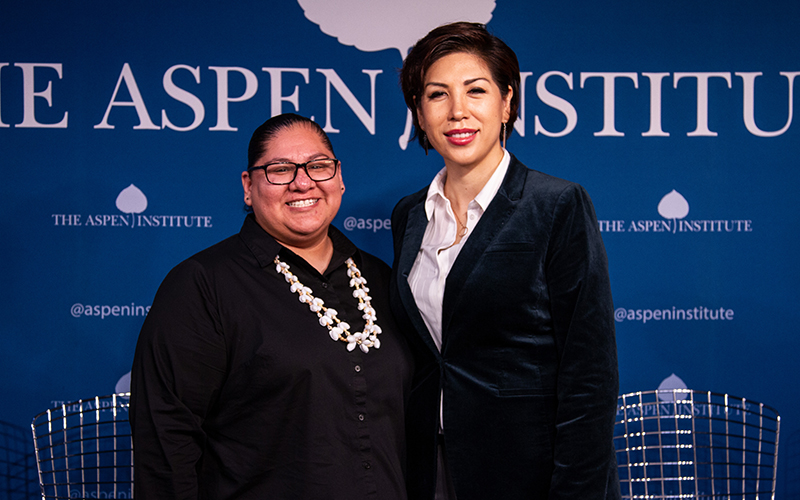Indianz.Com > News > Cronkite News: Native youth become leaders of tomorrow amid COVID-19

Grappling with loss of life and connection, Native youth become leaders of tomorrow
Wednesday, September 23, 2020
Cronkite News
PHOENIX – In March, Tawny Jodie was preparing to travel to Israel for her first trip overseas. By July, she was masked and delivering food boxes in rural New Mexico amid a deadly pandemic.
A full-blooded Navajo, the 20-year-old said she was compelled into service when COVID-19 started ravaging her community and others across the Navajo Nation.
With the virus disproportionately affecting tribal nations due to health disparities, poor infrastructure and chronic underfunding to fix persistent problems, young people like Jodie have stepped up to help others, preserve their culture and start the healing process.
Jodie is one of several young adults living near Window Rock, Arizona, who shared what their lives have been like these past few months – and what’s kept them going as they look ahead to a future beyond COVID-19.
Tawny Jodie
Before the pandemic, Jodie was attending the University of New Mexico in Gallup and working part time at Domino’s Pizza while living with her parents, a younger brother and an older brother and his family. After COVID-19 hit, another brother moved back in with his girlfriend and their son.
While she adjusted to living at home with nine other people, novel coronavirus cases across the reservation began to climb.
In April, with more than 350 positive cases, the Navajo Nation began enforcing 57-hour weekend lockdowns that prohibited people from leaving their homes for nonessential reasons.
“That really swept me off my feet, and I had no idea that all of these regulations would come,” Jodie said. “So I was just full of anger, resentment, bitterness, and I was just tired, like exhausted.”
It was especially tough when her study tour to Israel was canceled, but Jodie said she found a sense of peace by turning to God and service. She traveled with 26 high school and college students as part of a weeklong mission trip to Mariano Lake, New Mexico, to distribute food boxes to families and the elderly.
“Every day we’d deliver 10 to 12 boxes of food to families in the neighborhoods. … I don’t think anyone just asked them how they were doing during this time. So it was like a sweet meeting, just being able to get to know people and how they’ve been.”
After returning from that work, Jodie gave her youngest brother, Tawry, a hand tending to his 20 chickens and growing watermelon, corn, strawberries and tomatoes in his newly constructed greenhouse. It helped them grow closer.
Jodie’s passion for helping others and cultivating relationships is perhaps best seen in her work as a youth leader at a local ministry called HighLife Window Rock.
Nehamiah Hardy
It’s usually quiet outside 14-year-old Nehamiah Hardy’s house in Window Rock, unless he and his three younger brothers are out riding their bikes. With extra time on his hands this summer, Hardy has been volunteering at HighLife as a sound engineer, photographer and videographer for the digital videos they began making after the ministry moved online.
“It’s just been good to keep your mind off other things,” he said. “It’s kind of become a new hobby.”
Photographing landscapes and discovering new trails at nearby Window Rock park and memorial have helped him cope with the social isolation and devastation of the pandemic. In mid-July, he and his family took a road trip to Carlsbad, California, and although Hardy said he was hesitant at first, the change of scenery was a much-needed breath of fresh air.
“The sunsets were really nice and the waves, the sound of them. I know it probably sounds really overrated, but it’s really nice.”
Prior to the trip, Hardy’s uncle contracted COVID-19 and was in the hospital on a ventilator for two weeks. He’s home now and recovering, but Hardy recalls that time as “pretty shocking” and said he felt “speechless.” He’s tried to focus on being a role model for his younger brothers and encouraging them to wash their hands and help out around the house.

Brina Lee
In May, after finishing up her third year at Indian Bible College in Flagstaff, Brina Lee moved in with her mom in the reservation community of St. Michaels. Like so many college students, the 23 year old had to adjust her routine and grow accustomed to being back home under her mother’s watch.
She said their relationship has been difficult over the last several years, so it’s been challenging to live under the same roof. At the same time, she said, there have been “a lot of blessings” in rebuilding their connection and growing together in their Christian faith by “allowing the words (of the Bible) to penetrate through (her) heart.”
Although she is not close with her grandparents, Lee said seeing so many older people die across the Navajo Nation has been “frustrating” because of the wisdom that is lost with their passing.
“They had to endure through so much, and yet they’re taken out by sickness, by some virus. That’s something I’m struggling with: How do I not act out in frustration toward the virus? But how can I live through it?” she said.
Walking, praying and journaling have been a respite for Lee. She’s also discovered a sense of purpose over the last few months, whether that be by doing yard work to prepare for winter or by walking to a wooded area about 20 minutes from her home.
“I’m able to take my focus off of me and redirect it back to others … not being trapped in a four-(walled) room feeling helpless or lonely, but going out and seeing creation and feeling that fresh breeze or smelling the red dirt, like it really just makes your feet feel planted,” Lee said.
Note: This story originally appeared on Cronkite News. It is published via a Creative Commons license. Cronkite News is produced by the Walter Cronkite School of Journalism and Mass Communication at Arizona State University.
Search
Filed Under
Tags
More Headlines
Native America Calling: A unique festival celebrates Indigenous literature and arts
Native America Calling: Treaties more than a century old provide both guidance and constraints
Native America Calling: Language revitalization: apps, games, and classroom lessons help keep Native languages vital
House Subcommittee on Oversight and Investigations holds hearing on cartels in Indian Country
Native America Calling: Tribal broadcasters scramble; Native higher ed leaders fight to keep funding
‘We’re frustrated’: Lawmakers press Indian affairs nominee on key issues
Cronkite News: Fires cause problems for Grand Canyon’s tourist economy
Press Release: Oklahoma City Indian Clinic receives health awards
AUDIO: Confirmation hearing for William “Billy” Kirkland to be Assistant Secretary for Indian Affairs
VIDEO: Confirmation hearing for William “Billy” Kirkland to be Assistant Secretary for Indian Affairs
NAFOA: 5 Things You Need to Know this Week (July 21, 2025)
Press Release: National Congress of American Indians continues to oppose racist imagery in sports
Chuck Hoskin: Cherokee Nation prepares for the future of public safety
Native America Calling: Tribes confront resource-intensive drive of Artificial Intelligence
Statement: Corporation for Public Broadcasting on elimination of federal funding
More Headlines
Native America Calling: Treaties more than a century old provide both guidance and constraints
Native America Calling: Language revitalization: apps, games, and classroom lessons help keep Native languages vital
House Subcommittee on Oversight and Investigations holds hearing on cartels in Indian Country
Native America Calling: Tribal broadcasters scramble; Native higher ed leaders fight to keep funding
‘We’re frustrated’: Lawmakers press Indian affairs nominee on key issues
Cronkite News: Fires cause problems for Grand Canyon’s tourist economy
Press Release: Oklahoma City Indian Clinic receives health awards
AUDIO: Confirmation hearing for William “Billy” Kirkland to be Assistant Secretary for Indian Affairs
VIDEO: Confirmation hearing for William “Billy” Kirkland to be Assistant Secretary for Indian Affairs
NAFOA: 5 Things You Need to Know this Week (July 21, 2025)
Press Release: National Congress of American Indians continues to oppose racist imagery in sports
Chuck Hoskin: Cherokee Nation prepares for the future of public safety
Native America Calling: Tribes confront resource-intensive drive of Artificial Intelligence
Statement: Corporation for Public Broadcasting on elimination of federal funding
More Headlines